My first clematis was ‘Mrs. N. Thompson’, a spindly specimen from a local garden center, but I thought it was something spectacular because it was a clematis that wasn’t ‘Nelly Moser’. Up until that point, I was under the impression that the only two clematis that existed were ‘Nelly’ and ‘Jackmanii’.
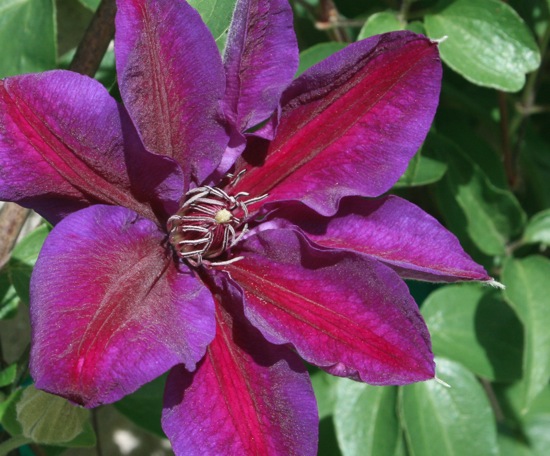
‘Mrs. N. Thompson’ never grew that well for me, in part because I don’t think it’s a great cultivar, but mostly because I now know that I did a lot wrong in growing it. But it introduced me to a plant that is my great gardening weakness. Every year I realize I have no more places to put more clematis and every year I buy more because they are just amazing plants.
I don’t know everything about growing clematis, but this post includes pretty much everything I know, and it has served me well in caring for the more than 30 clematis I have in my garden.
Many clematis are hardy from zone 4 to 9, but not all fall within the entire range, so double check that it will be hardy in your area before you buy.
All clematis want sun, although some can be pushed into part sun or even grow moderately well in some shade (‘Silver Moon’ grows—not rambunctiously, but it flowers—up the skirting on the north side of my deck).
This post may contain affiliate links. See the complete affiliate disclosure here.
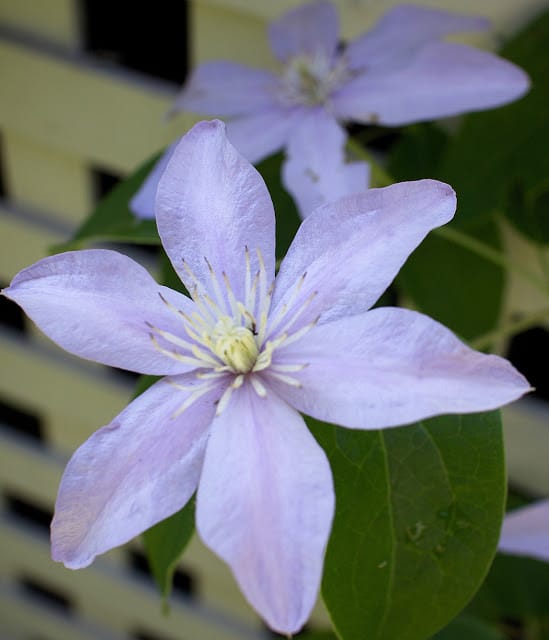
There is a long-standing saying about clematis that they “want their feet in the shade but their face in the sun,” and I think people take this too literally. When I planted poor ‘Mrs. N. Thompson’, I put chunks of fieldstone on top the roots (yeah, um, don’t do that). What I’ve learned is that they really just want moist, rich, soil to grow in with a nice layer of mulch on top (like a lot of plants); the shade part isn’t necessary.
Clematis is a rule breaker when it comes to planting. Typically plants should be placed so that the top of the soil in the ground is the same as it was in the container and planted directly in the native soil (turns out that whole “$10 hole for a $5 plant” advice was probably off base). But clematis are special (or for the kids out there: extra) and they want special treatment.
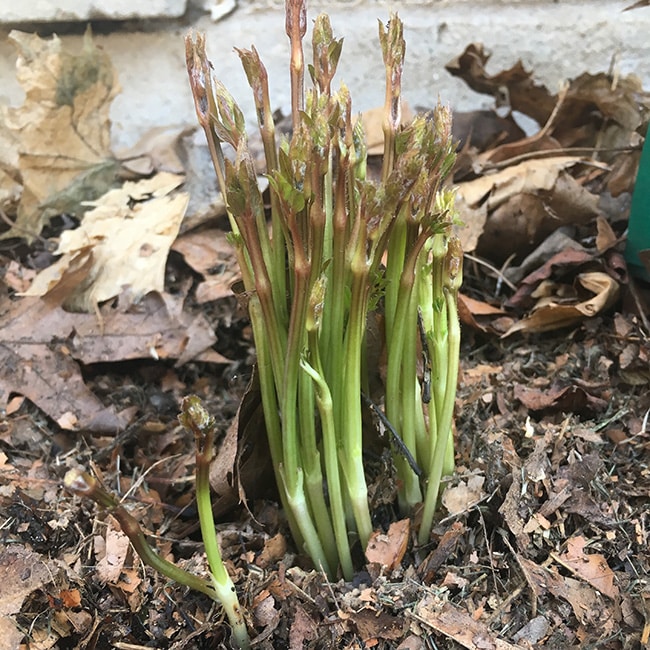
Here’s how I plant clematis. You will find variations on this technique and I suspect they all work, but I stick with what works for me. Dig a big hole, far bigger than the plant: about three times the width and twice the depth. Add in compost, well-rotted manure (it should not have a smell), a small amount of Espoma Rose-Tone and the soil you dug out. Place the clematis on a 45-degree angle toward whatever it will be growing up, with the crown buried 3 to 4 inches under the finished level of the soil.
(Edited to add: A kind commenter brought up that some people do not recommend this deep planting method for non-vining bush-type clematis. I’ve read that as well, but I read it after I had already planted many bush types deeply. I can report that all are doing well, but in the future I will probably plant them shallower.)
Fill in the rest of the soil and water it in really well. Mulch well.
And then, you need to do the hard part. If it’s not already been cut back, you need to cut those vines back. I know it’s hard, but you want it to worry about roots, not flowers or stems right now. So cut it back to about two leaf buds. I promise it’s worth it.
This is the part where people freak out about growing clematis. Don’t let it stop you.
Clematis, like most vines, are pretty big feeders. There’s a lot of growth to support there. I fertilize two to three times a year with Espoma Rose-Tone: once in spring when I prune, once again before they flower (for late-flowering varieties) and then after they are done flowering. Never when they are in bud or flowering (I don’t know why, to be honest, but I read it somewhere once, so that’s what I do).
Keep up on the watering, especially while they are getting established, because they like moisture (but not sitting in wet soil).
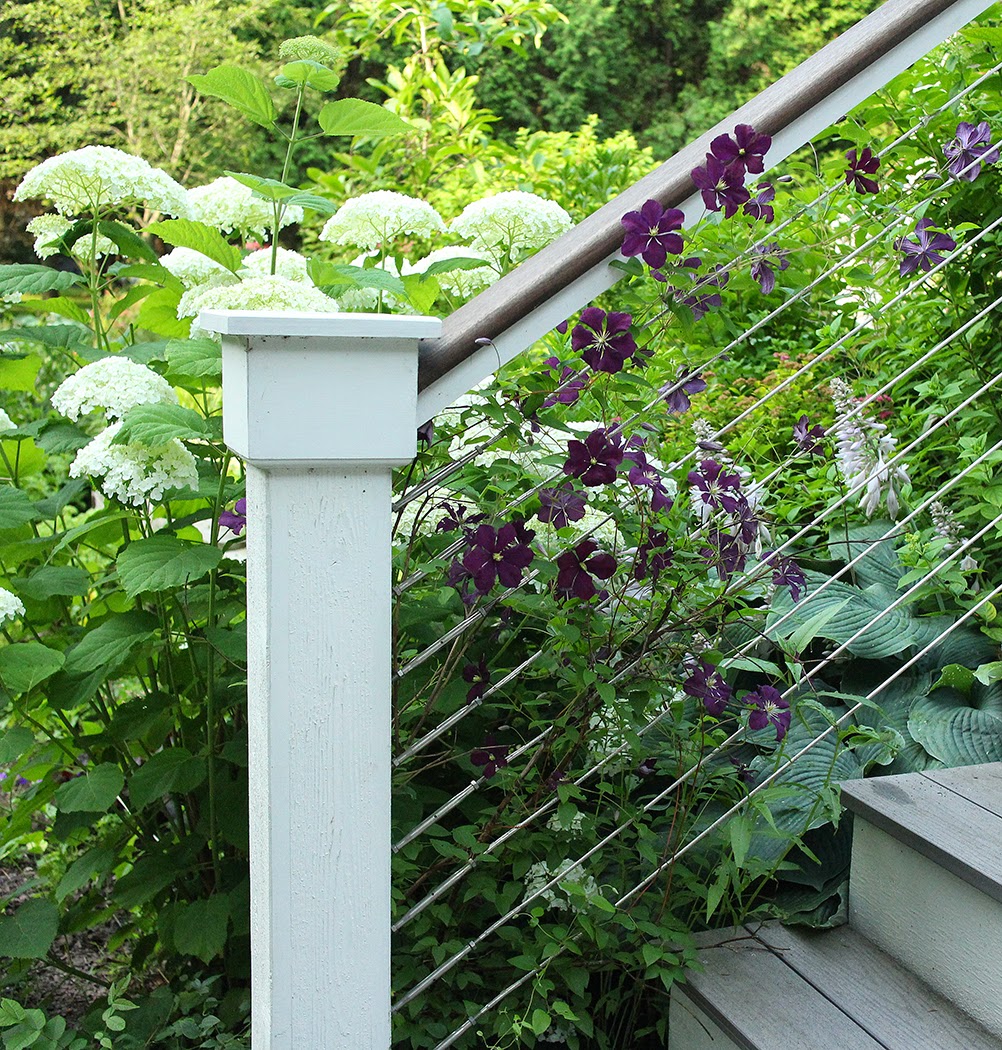
Pruning is the part that throws everyone for a loop, but the good news is that you won’t kill your clematis if you do it wrong. The worst case scenario is that you’ll either have few flowers or all the flowers will be very high up in the air. You need to know what kind of clematis it is. They are divided into groups and that dictates how and when you prune them.
The plant tag should tell you what pruning group they fall into or you can look it up by the name of the plant. If you’ve lost the tag and can’t remember the name, you’ll have to do a little detective work, but it’s best to just let it go for a year, observe how and when it blooms and make note of it for the next year.
Group 1: These bloom on old wood, so you only need to prune out dead or damaged stems. If you need to prune for another reason, do it after they bloom. Group 1 clematis bloom very early.
Group 2: These are probably the most common kind of clematis and the ones people think of first. I prune these in early spring, when buds begin to swell, following a rule of thirds. One third of the stems get cut back to about one or two leaf buds from the base, one third gets pruned to about half their length (height?) and the last third remains unpruned. Some Group 2s can be pruned again after flowering and they may rebloom in late summer or early fall.
Group 3: I love Group 3s because they are easy. Just prune them back to one or two buds from the base in early spring or late winter.
See? That wasn’t so hard, was it? The best visual aid I’ve found is on Margaret Roach’s website.
As for winter care, well, there is none. Just forget about them until spring.
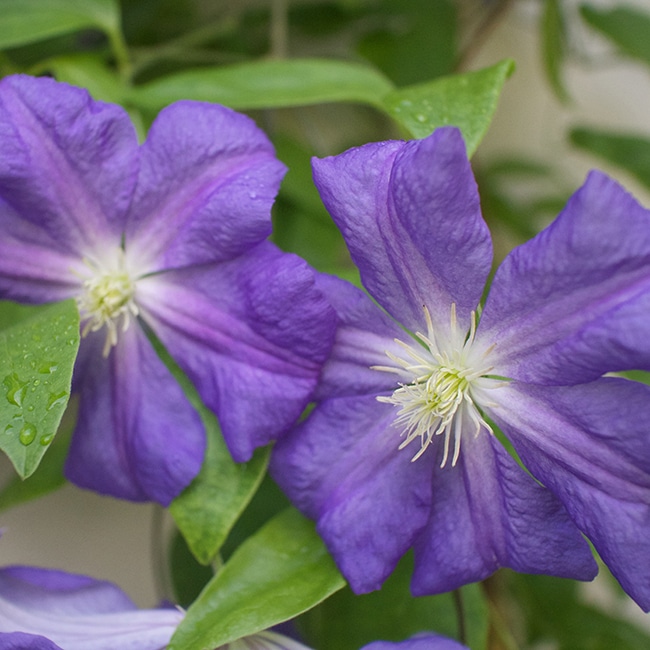
When you get addicted to clematis like I have, placing them is an issue. One can only have so many trellises. So I use nature’s trellises: that is, trees and shrubs in my garden.
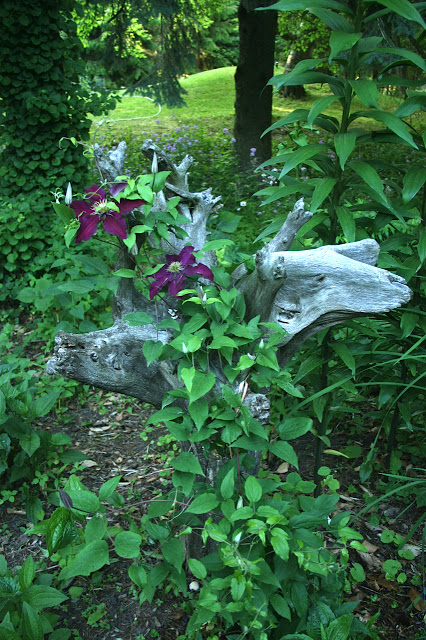
In fact, I think clematis looks best when it’s intermingling with something else. I grow ‘Prince Charles’ on my Limelight hydrangea and the flowers look like they are on the same shrub. ‘Gravetye Beauty’ gets a little help making its way up the trunk of the Serviceberry tree and then scrambles throughout the branches. A Group 1 clematis (whose name I cannot recall) grows up the magnolia tree off the deck and last year did a wonderful job disguising the face that the magnolia died.
I also grow clematis together and in the classic combination of a clematis with a climbing rose (although I’m swapping out the clematis I grow next to ‘Autumn Sunset’ rose on the front of the house because they never bloomed at the same time and it seemed like such a missed opportunity to me).
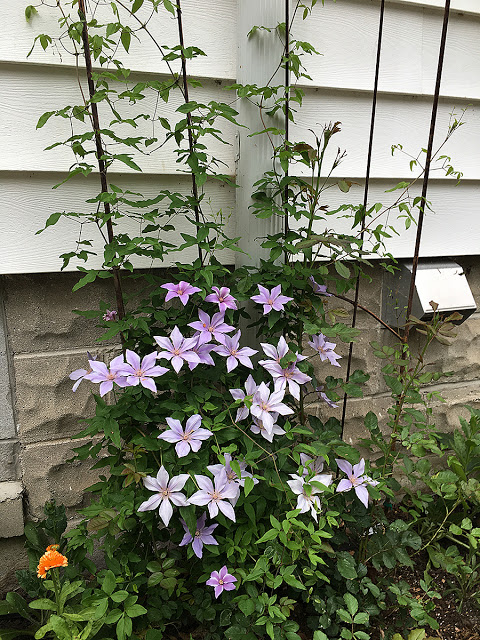
Lately though, I’ve become enamored with non-vining clematis varieties that stay short and flop over walls or meander among other perennials. They are Group 3s so they are easy to clean up, and they are an unexpected addition to the garden.
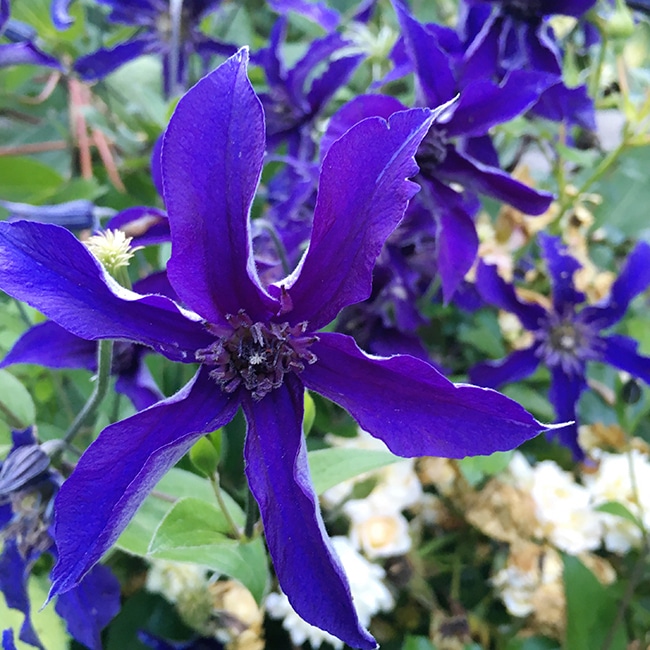
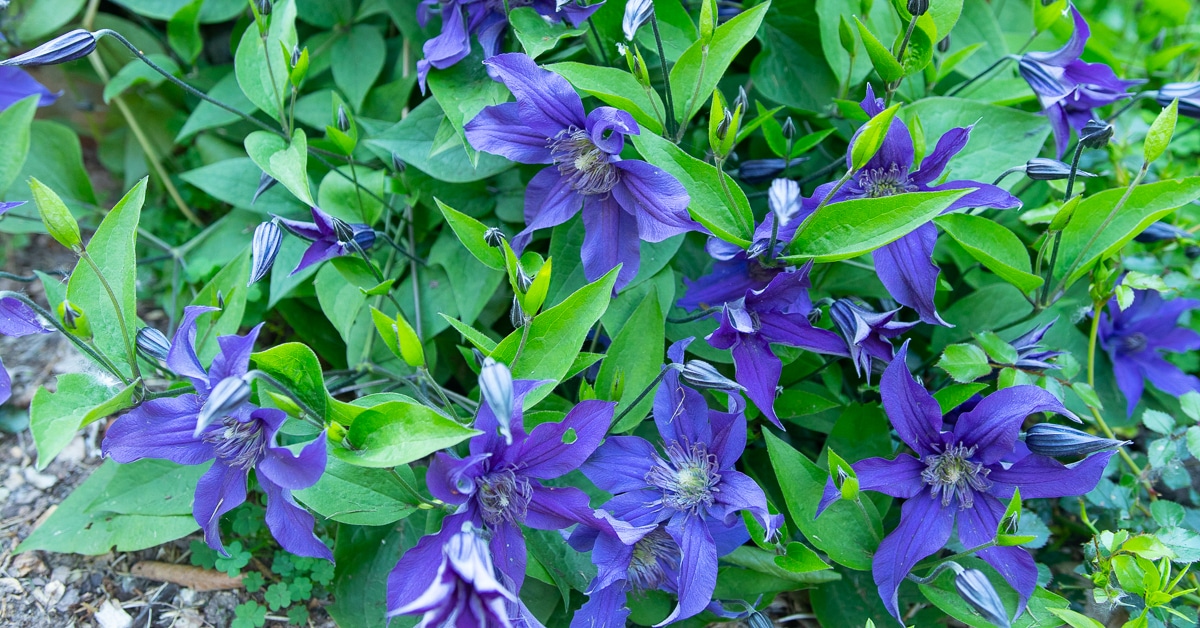
My advice to gardeners is usually to shop their local garden center first, but I stray from that advice for clematis. The clematis I see in garden centers are usually spindly, with just a few long stems, forced into flowering so they sell better. Remember, we want roots, not flowers, at first. There are exceptions to this, of course, but if I’m buying from a garden center I look for something with lots of stems coming from the soil, not a few tall stems.
Specialist clematis nurseries grow them best, in my opinion, so the two I recommend based on my personal experience are Brushwood Nursery and Silver Star Vinery. I’m sure there are other good clematis growers out there, I just haven’t ordered from them.
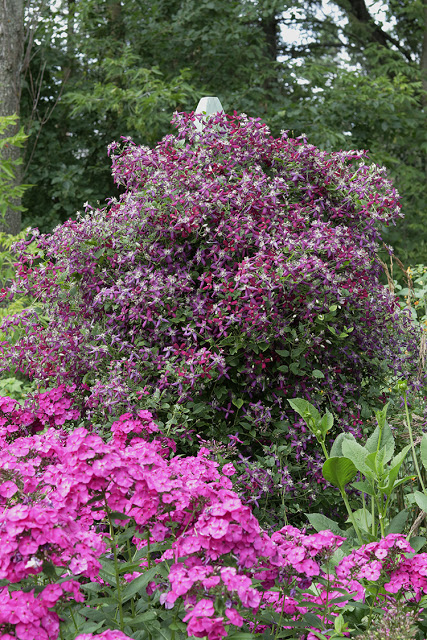
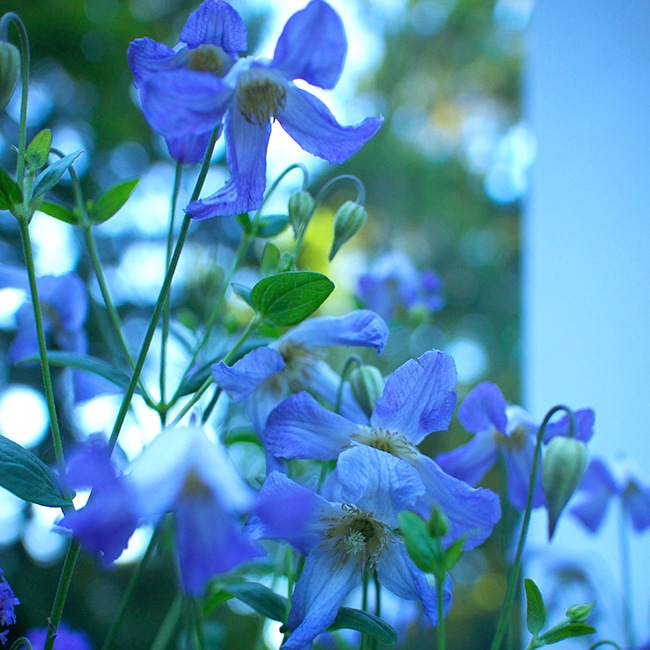
Well, how have you been saying it in your head while you read this? I am a firm supporter of the CLEM-uh-tis pronunciation, but there are a lot of clem-MAH-tis folks out there as well. Say it however you like, just grow them!
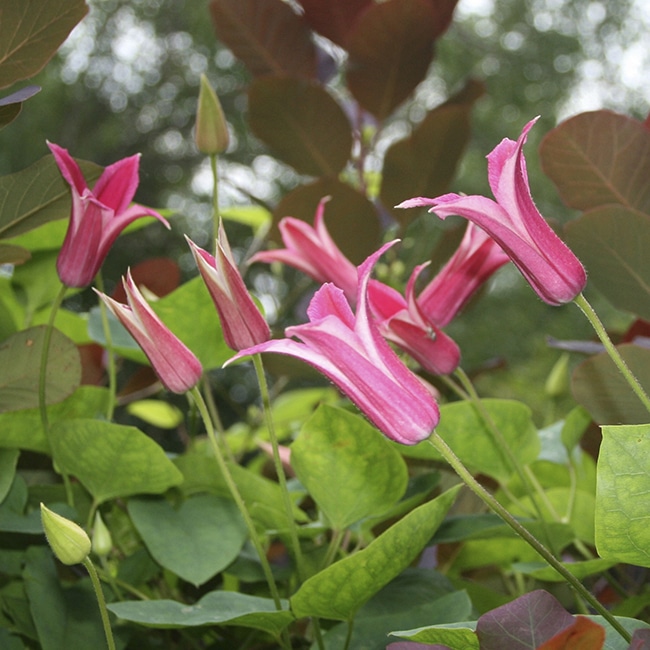
The Plant Lover’s Guide to Clematis is an excellent reference.
You know this is like asking a parent who their favorite child is, right? Well, I do have a few favorites, but I’m always discovering new clematis that I love as well.
- ‘Sapphire Indigo’: A Group 3 non-vining clematis with deep blue (OK, purple-ish) flowers that absolutely cover the plant for most of the summer. Great seedheads as well.
- ‘Guernsey Cream’: A classic Group 2 that blooms very early and is just so creamy wonderful. I’d never be without it.
- ‘Princess Diana’: I have two of this Group 3 clematis because I thought the first one had died and I couldn’t be without its tulip-shaped pink bell-shaped flowers. The first one was fine and now there are two.
- ‘Sweet Summer Love‘: A small-flowering Group 3 with a lovely scent and crazy amounts of flowers.
- ‘Etoile Violette’: Dark purple, long-lasting medium-sized blooms that combine so well with so many other things and happily climb up my deck railing.
I don’t grow ‘Stand by Me’, a new introduction from Walters Gardens and Proven Winners last year, yet but I have my sights set on a mass planting of it because it comes to me in my dreams. I’m only sort of kidding. (Update: I planted three ‘Stand By Me’ clematis in a clump in the new patio garden area I redid in summer 2019.)
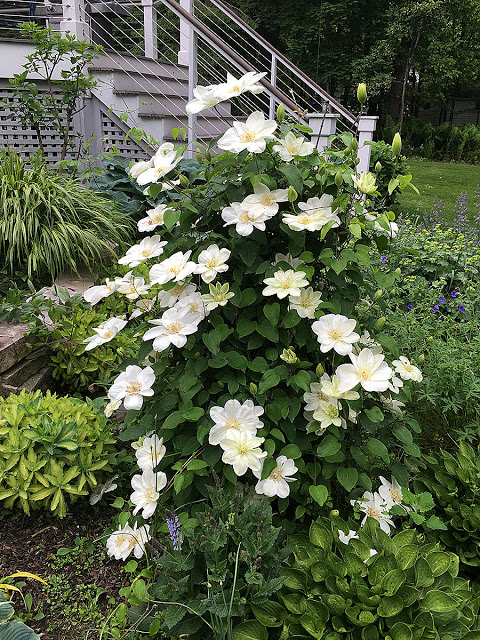
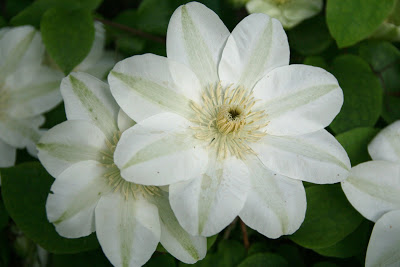
Well, yes, because there are downsides to any plant, particularly one that has such genetic diversity. Clematis wilt can be a problem with Group 2 clematis, although I don’t think I’ve ever experienced it. It’s a disease caused by a root-rotting fungus in which stems just suddenly wilt, often just as they are about to flower. To my knowledge, the only thing you can do for it is cut away the affected stems. Planting deeply helps new stems regrow and allows the plant to develop deep roots that will hopefully prevent clematis wilt from striking and, if it does, help it bounce back.
Some clematis are aggressive and even invasive in some areas. Sweet Autumn (Clematis terniflora) is a massive grower in most areas and will quickly cover anything and everything with a huge vine with thousands of small, white flowers. It is considered an invasive species in some areas, so handle that one with care.
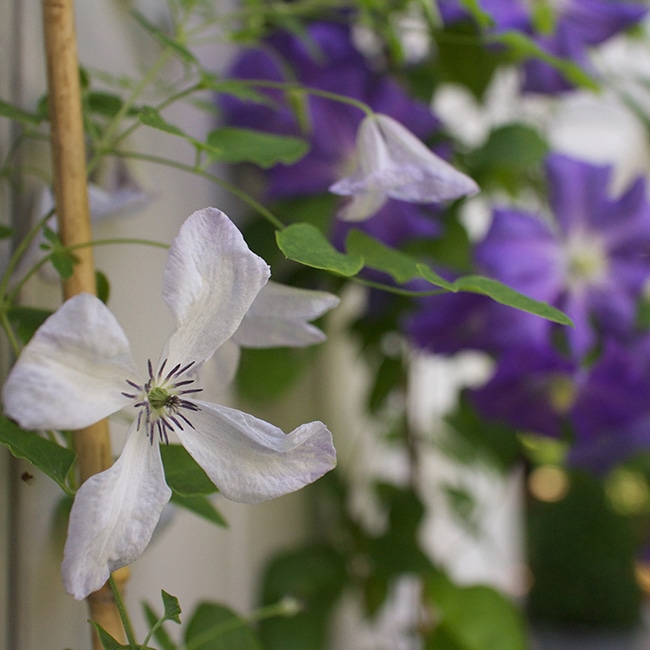
Other clematis are rampant self seeders. I presume this is highly dependent on where you garden because I’ve never had a clematis self seed in my garden in 17 years, but take note that some may have that habit in your garden.
Do you grow clematis? If so, I know you have a favorite. Share it in the comments. I might need to add to my collection.



59 Responses
Has anyone succesfully grown Vancouver Fragrant Star…a white, group 2, vining clematis? I’ve had two for 4 years and can’t get them to grow and vine much. I know I’ve not faithfully fertilized and mulched and they are not in the best location to receive the amount of sun they need. I may just resort to moving them this fall to a location where they receive more sun. Thank you for any help you can provide.
Thank you so much for all this info on climatis I have a new house growing everything in pots and great success. I am excited and purchasing more.
N.ireland.
This was very helpful. I discovered 3 different clematis growing in my yard. One of them is very happy, the other two not as much. They’re growing and climbing, but still no buds yet. So I have no idea what kind they are! I’m anxious to see what they do!
When is too late to prune back a clematis if it’s newly planted? I just got one from a garden center, have reported it but haven’t gotten it into the ground yet. It’s early April … Should I cut the growth back or just let it go this year? 🙏
We have had early warm days here in NC and my climatis vine is getting buds. Should I cut down the vines to about 4″ from ground or leave everything alone and just let them go?
The moments that take your breath away by beauty are the best ,I’m addicted to clematis ,I have a dozen in the ground a few in pots and 6 more that have been in 1gallon pots all year and must find a place for them .I have stressed when a cold snap comes early but it seems the clematis like it 😊I plan on creating other areas and trellises to satisfy my need .the nelly moser ,jackmanniI ,HFYoung and Ernest markham seems to be very easy and prolific ,my Wong has finally kicked in much to my delight and my new ones I can’t wait to see the pleasure they bring me.enjoyed reading your experience with them 👏🏻👏🏻
I have a Josephine clementis and I moved this year was afraid that I would kill her she had to be transplanted she bloomed for me this year I was so surprised and happy now I’ve got to unwind her from my tomato plants which I also had to plant in a container my question was the vines have little roots on them and I was wanting to know if they would grow into a plant if I took care of them so I will be trimming my clematis back instead of worrying about the vines and I thank you for that
Hi Erin,
Love reading your blog. I live in the Chicago area, so maybe our climates are similar. I also have bought clematis plants from my local nursery, but they are spindly and don’t do well. One is on the east side of my house on a trellis and gets some dappled sun in the morning and early afternoon. The other is on a trellis on the front of my house (north facing) with very little sun due to a wide overhang and a small tree in front, getting a bit of sun in the afternoon.
Do you know of any clematis plants (preferably in the pink & purple palette) that might grow in our region in these conditions? Also, where might I order them from?
Thanks so much.
This is the second summer for my white Duchess of Edinburgh clematis. I am growing it in a large container. I am experiencing the white flowers blooming then immediately turning an ugly brown. Do you have any idea how to prolong the blooms? Thank you in advance.
I also am smitten by clematis. My new favorite is Gravetye Beauty. Same shape as Princess Diana, but in my humble opinion, an even more gorgeous color: a glowing goblet of deep burgundy rose. To my delight, I have discovered the hummingbirds love it. I bought mine for a pretty penny from Broken Arrow Nursery in CT. I was so disappointed it died — or so I thought. Strangely, a good 3 or so years later, there it was, growing and blooming! I was thrilled, as you can imagine.
Hi, I’ve enjoyed reading your article about growing Clematis….CLEM uh tis! HAHA….and I just dug up a couple little clematis roots that have sprouted, and wondered if they will make another clematis for me? Have you ever done that? I have Nellis Moser, Autum something….multitudes of white flowers in the late summer and one that is red, but not sure it’s name. I had Jackmanii, but somehow it doesn’t live here anymore…I may have to get another one…I love them, and OH, I have just bought a Piilu and it is just a baby….looking for a good spot for it to grow this summer. Thanks! Pam
What clematis is best to go through my magnolia tree
I have a “John Warren” that has only been in the ground for about 4 or 5 months. I believe it has wilt. The leaves are turning brown & black and then dying. I dont know if I should prune it down like I have read because it’s so new. It’s getting pretty cold now in the Seattle area where I live and I’m afraid if I prune it, I might kill it. Any advice would be greatly appreciated. Thank you!!
I have been asking about clematis vines that have come up on their own in my flower garden. You are the only response that said this can happen. I know I didn’t plant those vines in such odd spots. I have planted a lot of clematis over the years and I thought they might have moved on their own. I am not sure what to do with them. they are growing heartily without a trellis. I was thinking about clipping them out but I have decided to see what they will do on their own.
Nancy in Ohio
My daughter lives in northern KY and planted 2 clematis last year. Both seemed to do well, flowering nicely, one was a little more vigorous than the other. Unfortunately, this spring showed us neither one survived.
She planted 2 new ones following suggestions on this page and now they have both died, rather quickly. The location is on the northeast side of their brick house, on a trellis next to the garage door. She was so excited to have clematis there.
Did she make a mistake planting these in the spring? Any other suggestions?
Hi Erin,
Great info on Clematis! I, too, have been bitten by the bug. I have been obsessed with clematis for the past 20 years. I live on Whidbey Island in WA state, so our climate is perfect for them. I have about 40 growing in my garden, and just ordered 5 more-where I’ll put them? I will make room!! My favorites (can’t pick just one!) are: Clematis Montana ‘Broughton Star’ (I know, your zone doesn’t support Montanas), Cl. Venosa Violacea, Cl. Minuet, Cl. Duchess of Albany (came with our house 25 years ago), Cl. Rugoochi, and my newest favorite, Cl. Princess Kate. I grow them in all the ways possible: onto trellises, into shrubs, roses, trees, etc. They are so versatile, and really very forgiving if they get enough water and feeding. I’ve learned through trial and error over the years and have lost several in my earlier days of growing them. The biggest advice I could add is that when buying a young plant, say in a 4-inch or even quart size, is to pot it up into a gallon-sized pot and baby it for at least a year-feeding it, pinching it back, resist letting it bloom, etc. so the root system can build up. I could never have a garden without clematis! It is nice to see someone as obsessed as me! I love your YouTube videos, Erin, and just discovered your blog. Thank you!
I’m in zone 6 and bought an established plant from a nursery and forgot to inquire when to plant, should I wait till after freeze possibilities? I assume they can take the frost and we have been hardening off during nicer days.
Appreciate your thoughts.
Love my guernsey cream and my Viva Polonia which has amazing color!
Has anyone grown Josephine? An exquisite double headed pale pink and purple flower. She was my mums absolute favourite and she always talked about Josephine as if she was a person! So she now grows in my garden as a beautiful reminder of her, and is a good listener. She really is stunning. Worth a look. Enjoy!
We are looking for a good climbing , flowering vine to cover and spread over a large “trellis” built with 6 vertical telephone poles and connecting supports that span the distance between the poles horizontally. Is there a variety of Clematis vine that would grow 25+ feet or more? I have one catalog that says the Paniculata might reach that length. I live in south/southeastern MN. Maybe there is another flowering vine that would be better for this area and our large trellis? We planted Honeysuckle the past two years, but it winter-killed last year and this year’s plantings are alive but not growing upwards hardly at all (still about the same size as they were in June when I bought/planted them). Thank you for any advice!
Is it safe to plant clematis close to house or garage foundations? I’m seeing a lot of conflicting information about whether or not they have invasive roots that could cause damage. I’m soon to move to a new home where I will finally have some sun in the garden, and I want to take advantage of it…but I don’t want to wreck the foundation!
So grateful I came upon your website. I love clematis and it is by far my favorite flower. Currently I have ten but 6 are recently planted or moved and my four oldest have suffered this year from I assume some sort of wilt? Your plants are spectacular. Thank you also for the resources for purchasing others. I hope to fill my little yard with clematis, IF I can ever get them to full growth and healthy. I will be watching your website for advice. Thank you again!!
Do you have any thoughts on the following problem. Last year I planted “Sapphire Indigo” for the first time. It came up nicely, and I was pleased. However, last fall I moved it to a new location. This spring it did not come up. Was it moving it the problem? And do you think it will ever come back? Thanks. Email is below if you would like to email a response. Thank, Debra in NH
Just a postscript — it is the 27th of June – three weeks since my last comment. The “Sapphire Indigo” is on the move! I’m not sure why it stalled out, but it is fine now. Debra
I see now, that planting a clematis deep in the ground is important for a few reasons. however when I purchase mine the directions said to leave the roots above ground, which is what I did.. now I’m thinking it should have gone deeper in the ground.. can I dig this plant up and try to lower it or just leave it alone? I have noticed wilt lately, thinking this may be part of the problem.. HELP!
Hi Erin,
I just found this article while looking for information on growing clematis in a shrub. I have four Miss Kim Lilacs growing on the south side of my house that I’d love to grow something through. They’re in full sun.
I read another article that said that type 3 was the best for growing in a shrub, but I’m wondering if it’s a pain to disentangle the vine when trying to cut it back. It seems like with type 1, I could just plant it and forget it, but maybe that type gets too big for the shrub. Can you suggest a good one for growing in a four foot tall shrub? Thanks for the good article and any additional advice you can give me.
I have about 80 clematis in zone 5A Vermont. Decided that most roses would not survive our winters but wanted a flowering plant that climbs and is cold hardy in our area so started buying clematis. I especially enjoy the following clematis; Arabella as she only grows 3 feet tall and produces many flowers, Betty Corning that is very fragrant and has a charming flower, Huldine a hulking monster that has a beautiful white flower, Helios a smaller size tangutica, Asao a beautiful type 2 clematis, and Ville de Lyon which has an exquisite colored flower.
Thanks for these ideas Scott. We’re over in Madbury, NH and I just put in my first ‘Arabella.’ I’ll try out some of the others you described. Thanks, Debra
Hi Erin,
Thank you for the informative post. I am interested in planting a few clematis this spring. I live in zone 5B. When would you plant clematis in the spring—as soon as the soil is workable? Or do you wait until later in the spring?
I have a stair leading up to my deck, and was hoping to have the clematis climb up the bannisters and railing. Once the growth the long enough, will the vines be able to wind and climb up the wood bannisters or do I need to add additional trellising?
Thanks!
I have an Avalanche growing on the front of my house – early blooming evergreen, to add some interest before my numerous roses bloom.
In my back garden, I have a Perle d’ Azur growing up a wall with a yellow climbing rose (Golden Showers) and a couple of Fuji-musume (a wonderful mauve group 2, if you’re not familiar with it) growing up a fence behind a small row of white bush roses (Iceberg). Clematis really is a great companion plant for roses!
I’m wanting to get another clematis to grow up a 7ft post on my garden shelter, but can’t decide what to get (or whether to try to train it along the edge of the shelter roof).
Of all the clematises we have, the most reliable and healthy is ‘Nelli Mosher.” I’d recommend it for your 7ft post! Thanks, Debra
This year a strange thing happened. I had 2 more unusual varieties of clematis growing on my arbor and also the Sweet Clematis which always seems to crowd everything else out. This year the Sweet Clematis was gone and I had lots of leaves from the other 2 but very few flowers. Any ideas?
Hmm … that is a bit of a mystery. Something odd happening in the soil in that spot?
I’ve been a huge fan of your blog for years, and this post is pure gold for it’s value…. thank you thank you thank you!
I JUST came across your post because I was looking for info on planting & taking care of clematis. I have loved them forrrrevvvver! Especially after renting a home that had a huge, tall purple one adjacent to the master bedroom window. I would lay on the bed & just gaze at it & brought me such peace. Now, in a home of my own, I want to grow several in my yard. Thank you for your post & any other advice to this novice would be greatly appreciated! Take care
I have a couple of clematis that have been in the ground a couple of years. They have always been beautiful. However this year they came out, bloomed with a couple of promising blooms then we had a frost. This killed the new growth but I was not worried as this had happened in the past. The puzzler is that they have been growing a month or so now but are now miniature. Growing in small clusters along each joint if the old wood. I have two blossoms that have opened that are about the size of a half dollar (and that is stretching). There is also new growth that is full of blossoms that are also miniature.
I have had different clematis for 25 years but have never seen this happen. Are you familiar with this happening?
I have photos but am unsure how to attach or if they can be attached.
I have had this happen with my Arabella this year, but not due to frost. It developed powdery mildew early in the summer due to the humidity I think and because the stems needed thinning and were very overcrowded and tangled (it is a vigorous grower). It survived the powdery mildew but carried it to a degree all summer. The flowers grew smaller and smaller until they were very tiny. Masses of them though so it still looked very pretty. I understand that the powdering mildew suffocates the plant so probably due to this. It has finished blooming earlier than usual too as it usually carries flowers into September. It is mid August and the last few are now coming to an end. I have cut back by about a third and wonder if it might produce some more as I noticed a new bud on some new growth coming from near the base of the plant.
Thank you for such an informative article! Love, love clematis! After learning of your abundant amount of clematis, I had to take a count of mine — I haven’t kept track, just keep buying ’cause I can’t resist : ) I have 20 and after seeing the pictures of Guernsey Cream and Sweet Summer Love, I suppose I will be adding a few more…
It is hard to pick only a few favorites, but in love with Roguchi, Viticella Alba Luxurians, Sapphire Indigo, Arabella, and Duchess of Albany. I planted a Princess Diana two years and it is so beautiful. Donohue’s Greenhouse in Faribault, Minnesota is a great resource for clematis. Every spring, I gather up my sisters and parents to take a field to buy plants (I live about an hour and a half away). Happy Spring!
I’ve read in clematis fb groups that not all can be planted deeply. I’d heard in the past that it’s the ones with the roots that are more “stringy” can be planted deeply but the ones that have roots that grow more as a mass should be planted at ground level. I think the non-vining “bush” clematis are some that should be planted at ground level. When I plant the type that are to be planted deeply, I think of how to plant a tomato, where each bud could sprout would produce additional roots when planted under the soil level.
Thanks for your nice article on Clematis … I love them as well. Rouge Cardinal is probably my favorite.
I’ve read this as well, and it’s probably good advice. I actually thought I had included that in the article but I must have forgotten it. In any case, it’s something I first read about a year ago or so, well after I’d planted many bush-type clematis deeply. All of those are doing really well so perhaps it’s one of those things that doesn’t make a big difference or maybe I’m just lucky. Cardinal Rouge is a beauty. I don’t have a lot of red clematis for some reason.
Clematis are so pretty. I planted my first one last year, Little Mermaid. I ordered it from one of the catalogs that showed up at my door and it came so tiny, with just one stem all summer. I’m hoping to get some more stems this year, I’m going to try fertilizing with the rose tone like you suggest. I need to get a couple more to plant in my back yard. What is your favorite kind of trellis for clematis?
I have ‘Little Mermaid’: Beautiful flowers on that one! Good luck with it. As for trellises, to truly twine up something, it needs to be small enough for the tendrils to grab on, but not too small, like fishing line. Quarter-inch to half-inch trellis bits seem to work really well, but I do grow them up thicker wood trellises and just help them along. And of course shrubs make great trellises.
I am also a fan of Guernsey Cream. It’s an early bloomer and the soft yellow-green of the buds just sing. I pick them as buds and combine them with the flowers of Alchemilla mollis and pink peony.
Oh that sounds like a stunning combination.
Great article, Erin. I didn’t know they could be planted deeply and have been worried that I was getting them too deep when I pile on the compost mulch, so that is good to know! One of my favorites has turned out to be Roguchi. It has bell-shaped blooms that are dk blueish purple (very close to a blue anyway). It is non-vining in that it doesn’t have twining petioles, but it gets pretty tall so I weave it up some lattice next to a patio. It has been pretty vigorous for me in my Z4, sandy (but amended) soil.
Another one I tried last year (which I may live to regret because I’ve read it can be a pest in some soils) is the yellow blooming Tanguitica. I wanted something to vine up a birdhouse pole in my hot (yellow, orange, red) border. It has charming little blooms, was very vigorous, and had delightful seed heads. This will only be year 2, so we’ll see how it goes. It is a #3, so I would think I should be able to keep it under control by pruning to the ground each spring.
Am planning to try Princess Diana this year…it looks lovely and could go in a border without much support, it seems. Thanks for the inspiration to grow these lovely plants!
I tried Tanguitica once and it did not go well for me. I should try it again to see if that was a fluke.
Love clematis & had several Betty Corning in our Albany home. The plant was named for the avid gardening wife of our long term mayor and it was a beautiful cultivator. We just ( this week!) moved from Albany to Cape Cod so have the opportunity to learn new soil and weather requirements but am certainly going to try some of your suggestions ( as well as my old favorites) here. Thanks for the tips and ideas.
Thank you for sharing the story of how ‘Betty Corning’ got her name. I love that plant even more now. Good luck in your new garden!
I have grown the Bush clematis for years. I first saw it at a RHS Show in England. I love the color and the butterflies and humming birds love it also. I’ve also grown Heneryii and a few others, and with a major garden redo I plan on trying a lot more.
I appreciate this overview of clematis. Please excuse me. I will be outside moving one of my clematis that I planted in too shady of a spot.
Will be adding to my collection due to your encouragement in this post.
Very pretty gardens. I grew a clematis on a large azalea in my old yard. People walking by would always ask what kind of bush I had when the clematis was in bloom! I also had several varieties growing on a cedar trellis behind some boxwoods. I need to get some planted in this new house –thanks for this info. Also, we used to have the deer nibble on the vines now and then.
I love when the clematis growing through a shrub throws people off.
Thank you for a very good article. I have several clematis and love them. I have planted several more on a neighbors fence that divides our property and am trying to cover up the ugly fence. We live in the country and years ago they had horses. So will follow you advice on fertilizing as I’m not good at remembering.
i still have 3 of the jackmani, they do great for me a d i love the purple flower
What type of fertilizer do you use for Clematis that is living lovely on a trellis. Would it be 10 10 10? Or something a little different?
Thank you.
Do you know of a clematis that stands upright and has stiff stems? It is about five feet tall. I lost the info on the plant but I was sure it was a clematis. But it has not bloomed in four years so I am clueless what variety it is. I plan to move it and hope for better success. I love clematis, too!
I have one like this. It is a non twiner. It has grown so far at 3 years old to around 5ft this year after annual pruning. It is a number 3 type. Although it has stiffer stems it still needs support. Alternatively it can be allowed to ground cover in a very large bed. It is called Arabella and has small to medium mid blue flowers with creamy yellow stamens. It is very pretty and blooms all summer long. Mine currently has loads of nice size buds. It is tied against a cream trellis on a very dark slate coloured fence. This may not be the same as yours but I hope it may be.
It suffered from wilt when it was in a pot but has done really well since planting in a bed.